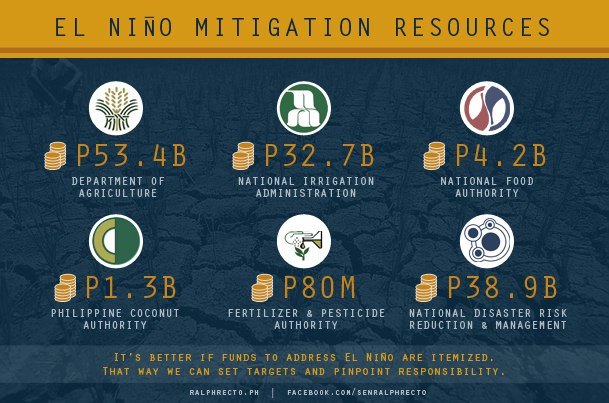To prevent drought in funds, Recto wants specific El Nino funding in 2016 budget
Despite the threat of an El Niño depressing farm output and dampening economic growth, there is no fund in the 2016 budget which is specifically earmarked to cushion the effects of the projected dry spell.
“Is there a single peso in the P3 trillion budget which is labelled as an El Niño mitigation fund? The answer is no,” Senate President Pro-Tempore Ralph Recto said.
While Recto admits that there are funds in the next year’s budget which can be tapped to mitigate the effects of the climate phenomenon, it would be better, he stressed, that these be “classified from the very start as an El Niño fighting fund.”
“El Niño should be a macroeconomic assumption of the budget. If treated as such, then we can tailor the budget so that the end result is that there will be no drought of funds in tackling El Niño. It’s better if funds to address El Niño are itemized. That way we can set targets and pinpoint responsibility,” Recto explained.
“The challenge is to set aside and label these funds as El Niño mitigation resources,” he said.
In its second semester outlook, the Philippine Atmospheric, Geophysical, and Astronomical Services Administration (PAGASA) said 32 provinces will be affected by the dry spell which will begin in July and taper off in May 2016.
But scant rain in the first half of the year already shrank rice, corn and sugar cane harvests for the period.
Recto is proposing that “El Niño adaptation programs” be written into the language governing the use of farm and disaster budgets for 2016.
These are:
· P53.4 billion for the Department of Agriculture (DA), including P5 billion in budgetary support to six DA-attached agencies
· P38.4 billion for the four agencies under the Office of the Presidential Assistant for Food Security and Agricultural Modernization (OPAFSAM), broken down as follows: P32.7 billion for the National Irrigation Administration (NIA); P4.2 billion for the National Food Authority (NFA); P1.3 billion for the Philippine Coconut Authority (PCA); and P80 million for the Fertilizer and Pesticide Authority
· P38.9 billion for the National Disaster Risk Reduction and Management also known as the Calamity Fund
“In all, there’s almost P131 billion next year from which funds for El Niño mitigation can be drawn. The next step is to create specific mandates in each for El Niño abatement,” Recto said.
In calling for such earmarking, Recto cited next year’s Calamity Fund which sets aside P18.9 billion for reconstruction of Yolanda-hit areas.
“At present, if you examine the budget of these agencies, you can’t find a specific instruction on El Niño. My take is that it should be incorporated there even for signalling purposes, to convey to our farmers the message of hope that there’s money to fight off this dry spell,” he said.
Recto, however, said that government need not wait for 2016, to kick-start El Niño mitigation measures.
“It should be done now. You prepare for dry spell when there’s still some rain. When you start building a dam when the spring had dried up, then it’s too late,” Recto said in stressing that “2015 funds are still available.”
He cited the case of the P14 billion Calamity Fund this year whose latest balance according to the Department of Budget and Management’s records is P9.6 billion.
“The Calamity Fund can be used for pre-disaster operations and other activities that would build up resiliency, so dapat magamit na ito,” Recto said.
On top of this is the P6.7 billion in Quick Response Fund (QRF) which is embedded in the budget of seven agencies, including the DA which has an assigned QRF of P500 million.
This year, too, the DA and the OPAFSAM have a “combined budget of P89.1 billion,” Recto said.
NIA, one of the OPAFSAM agencies, has money to open up 20,650 hectares of riceland to irrigation and rehabilitate existing systems in 23,200 hectares, Recto said. “This El Niño mitigation measure should be nearing completion by now.”
He said DA’s 2015 budget for rice production of P6.9 billion should have been used to guide and support farmers in using drought-resistant seeds.
Recto said all efforts must be done to shield the farm sector from “the withering effects of El Niño” as it accounts for 11 percent of the GDP.
“Agriculture also employs one-third of the labor force. And the most important thing is that we can’t afford for the prices of food to go up due to a supply crunch caused by El Niño,” Recto said.


